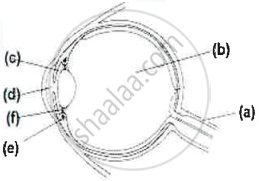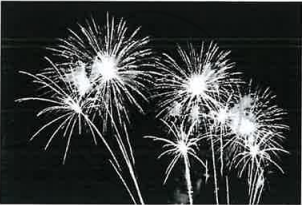Advertisements
Advertisements
प्रश्न
Given below is a cross section of the human eye. Match the structures marked (a) to (e) with their correct functions:
Example: (f) - 6. Holds the lens in position
| Cross section of Human Eye | Functions | |
 |
1. | Protects retina |
| 2. | Regulates the size of the pupil | |
| 3. | Alters the shape of the lens | |
| 4. | Keeps the lens moist | |
| 5. | Transmits nerve impulses to brain | |
| 6. | Holds the lens in position |
उत्तर
- 5. Transmits nerve impulses to brain
- 1. Protects retina
- 2. Regulates the size of the pupil
- 4. Keeps the lens moist
- 3. Alters the shape of the lens
APPEARS IN
संबंधित प्रश्न
List the parts of the human eye that control the amount of light entering into it. Explain how they perform this function.
Write short notes on the following: Retina
Name the part of the eye:
which controls the amount of light entering the eye.
State whether the following statement is true or false:
The image formed on our retina is upside-down
Ciliary muscles of human eye can contract or relax. How does it help in the normal functioning of the eye?
There are two types of light-sensitive cells in the human eye:
Where are they found?
Name two animals having eyes:
one the sides of the head.
Name the following:
The photoreceptors found in the retina of the eye.
Note the relationship between the first two words and suggest the suitable word/words for the fourth place.
Cones : Iodopsim :: Rods : ______.
Sometimes you remember a vivid picture of a dream you saw. What is the role of your eyes in this experience?
Choose the correct answer.
Aperture controlling passage to light into the eye is ___________
Give Technical Term:
The cells of the retina that are sensitive to colour.
State the Function:
Cornea
Write an Explanation.
Minimum distance of distinct vision
Write an Explanation.
Power of accommodation
We cannot distinguish colours in dim light. Explain giving suitable reasons.
From where the following nerves arise.
Optic nerve
Chris was watching the display of fireworks in the sky.

- Trace the path of the light rays using the following terms:
Fovea, Lens, Conjunctiva, Pupil, Cornea. - Name the nerve that carries the impulse for vision to the brain.
The layer in the eye where sensory cells (rods and cones) are located ______.
Give reason:
Blind spot is considered as 'area of no vision'.
